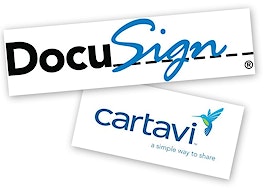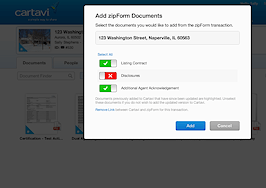Cloud-based transaction management platform provider Cartavi has launched a broker version of its system that gives brokers insight and control over all of the deals in their office.
Brokers have the option to co-brand the tool with their logo, and can set customized access authorizations, develop workflow templates, ensure process compliance and monitor deal activity in real time. Brokers retain ownership of transaction data when agents leave, and can decide whether to archive or discard done deals with the new tool.
The broker tool was designed to give brokers a window into their firm’s transaction data. Stats on a firm’s transactions can be broken down by month or other time periods, said Cartavi co-founder Glenn Shimkus, who manages the product now as vice president of real estate solutions at e-signature provider DocuSign, which acquired Cartavi last year.
Cartavi co-founder and product manager Glenn Shimkus introduces the new broker version of the transaction management platform.
In the product’s dashboard view, brokers can see the number of their firm’s transactions broken down by category: approved, under review, pending, expired, lost, and more.
Cartavi also built a software program to help firms access the raw data behind the dashboard view and build their own, customized transaction data reports, Shimkus explained during a demo of the new product.
The tool, which also offers both communal and private cloud-based storage of up to 100 GB per agent, also allows brokers to drill down into specific transactions and see a chronological log of all the activity associated with a deal and its basic info.
Brokers and managers can also set up the platform’s notifications system to send them real-time alerts when an agent has viewed or modified a document. They also have the opportunity to make notes through the platform on specific documents in deals that reveal why they rejected (or approved) them and what needs to be done to make them compliant with the firm’s protocol.
Cartavi, which launched its agent-focused product in 2010, is relatively late to the game with its broker-focused product.
Dotloop, one of Cartavi’s chief competitors in the transaction management space, launched a broker dashboard product in 2009 that gives brokers real-time insight into their deals and includes other elements similar to Cartavi’s new tool.
In 2013, dotloop grew its brokerage clients by 200 percent to more than 3,000 firms and is now placing a heavy focus on brokers in its business.
“We’ve found that the best way to reach agents is through brokers,” Allison told Inman News in January.
Cartavi had a reason for taking its time to develop a broker version of its platform, Shimkus said. When he began working on the product in 2009, he felt that tech firms were neglecting the agent, so he wanted to focus on something agents would want to use, he said.
“If the agents don’t use it, you’re not going to get the adoption,” Shimkus said.
The timing is right for Cartavi’s broker product, Shimkus said, because of the large penetration the tool has with some brokerages and with the new resources at Cartavi’s fingertips thanks to its acquisition by DocuSign.
For example, Cartavi went from a 13-person team in May before it was acquired to more than 40 now, Shimkus said. Since then, the platform’s mobile development team has grown from one full- and one part-time employee to nine, which helped make the platform fully mobile-optimized in October, he said.
Other changes associated with the DocuSign acquisition include the retirement of the Cartavi name, which is set to occur in early March as the transaction management platform is rebranded and further integrated into its new firm, Shimkus said.
DocuSign launched its e-signature and Cartavi products as a bundle to agents in November for $35 per month.
Shimkus says DocuSign is currently onboarding hundreds of brokers to the new tool, but has not set its pricing for the product.
Cartavi expects to solve one of the key issues for transaction management platforms — access to proprietary real estate forms — by focusing on integrations with other technology platforms like the form-filling technology zipForm from zipLogix Inc., Shimkus said.
Cartavi announced an integration with zipForm in October that makes it easier for users to move completed documents from the tool to Cartavi. In the summer, Shimkus said, that integration will deepen, allowing Cartavi technology users to fill out forms within Cartavi using zipForm technology.
In January, Cartavi announced an integration with the cloud platforms Google Drive, Dropbox and Microsoft SkyDrive and the ability for users to capture in-person digital signatures from a tablet.






